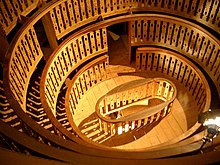User:Martina.straffi99/sandbox
| Anatomical Theatre of Padua | |
|---|---|
Teatro Anatomico di Padova | |
 | |
 | |
| General information | |
| Type | Theatre |
| Architectural style | XVI century |
| Location | Palazzo del Bò |
| Address | Via VIII Febbraio, 2, 35122 Padova PD |
| Town or city | Padua |
| Country | Italy |
| Coordinates | 45°24′24.16″N 11°52′38.78″E / 45.4067111°N 11.8774389°E |
| Current tenants | Università degli Studi di Padova |
| Inaugurated | January 1595 |
| Technical details | |
| Material | Stone and wood |
| Design and construction | |
| Architect(s) | Paolo Sarpi and Dario Varotari |
“1222. Messer Giovanni Rusca of Como, podestà of Padua. In this period the studium of Bologna was transferred to Padua, and on Christmas Day after mass there was a great earthquake.”[1]. This caption attests the foundation date traditionally accepted for the origins of the University of Padua.[2]. The events that led to the construction of the Theatre could be dated back to the thirteenth century, when Peter of Abano performed the first autopsy we have records for in Padua. Pietro d’Abano (c.1250- c.1315), was called to Padua from Paris as a teacher of medicine, philosophy and judicial astrology. His early studies in Costantinople allowed him to translate some of Galeno’s works from greek to latin: thanks to his work, the fame of the Studium spread rapidly throughout Italy[3]. It is worth noting that in Padua already existed a well established practice of dissection since the end of the thirteenth century. In fact, a traditional legend hands down the story of avaricious man’s heart found in a basket by St. Anthony; the heart is described in a scientific way, and that shows how the direct observation of the corpses was already considered essential.[4]
